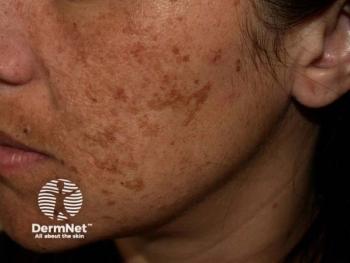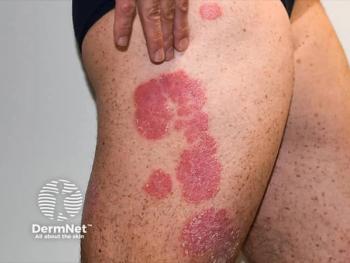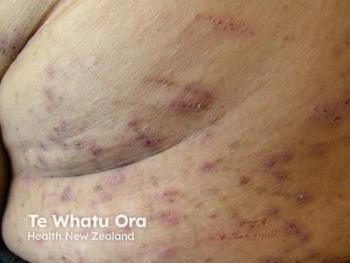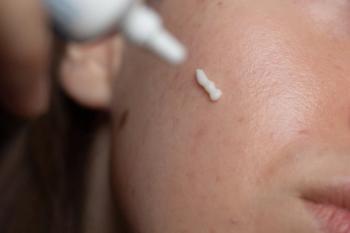
Empowering Patients and Families in the Management of Vitiligo
Key Takeaways
- Early intervention in vitiligo, particularly facial, is crucial for effective treatment outcomes, with ruxolitinib cream showing high efficacy in clinical trials.
- Step-therapy protocols pose barriers to accessing advanced therapies, highlighting the need for awareness among clinicians regarding insurance-mandated step edits.
At a recent Dermatology Times Case-Based Roundtable event, Stephanie Simmerman, DNP, APRN-C, discussed treatment selection, access challenges, and more for patients with vitiligo.
At a recent Dermatology Times
“We had a wonderful roundtable where we spoke on vitiligo in the adult and pediatric populations. We talked about a modality of treatment options that are at our fingertips; some that are a little bit more archaic and have been around for decades, and then some of the newer, more innovative topicals that are on the market,” Simmerman said.
Case No. 1: A Black man aged 28 years first noticed small depigmented patches on his cheeks 2 years ago. The depigmentation was initially stable and localized; however, it spread over the past 12 months. The patient now reports new, larger depigmented patches on both cheeks, hands, and forearms.
The patient has a medical history of no prior treatment for his vitiligo, and he would like to try something new now that the areas of pigmentation are more noticeable. According to the patient, the areas of depigmentation on his face are causing him significant distress, and he is uncomfortable in social situations.
Simmerman’s Insights: The roundtable conversation emphasized both medical and access-related barriers, particularly the limitations posed by step-therapy protocols, where prior treatment failures are often required before initiating advanced therapies such as ruxolitinib (Opzelura; Incyte). Attendees who were unfamiliar with insurance-mandated step edits found this to be an important learning point. Additionally, the case highlighted the urgency of early intervention in progressive disease and the high efficacy of treatment, especially for facial vitiligo, when initiated promptly. Simmerman also pointed out phase 3 data from the TRuE-V1 (
Case No. 2: A White woman aged 35 years presents with large areas of depigmentation on her back and elbows. The areas of depigmentation have rapidly spread over the past several months and now cover approximately 8% BSA.
The patient has a medical history of autoimmune thyroiditis. She also infrequently used topical corticosteroids but stopped due to difficulties applying them to her back and seeing minimal repigmentation.
Simmerman’s Insights: Simmerman addressed management strategies for a patient with a larger BSA and prior topical corticosteroid use. The conversation focused on the distinction between rescue and maintenance therapy, highlighting challenges with disease recurrence after corticosteroid discontinuation. A key takeaway was the expanded utility of ruxolitinib cream, which can be used on up to 20% BSA in adults, making it a viable option for patients with more extensive involvement requiring longer-term control. In this case, Simmerman noted that due to the location and extent of the patient’s vitiligo, the decision was made to start phototherapy with excimer laser twice weekly. As Simmerman pointed out, a 308-nm UVB laser reduces inflammation, stimulates melanocyte proliferation, and can be used when there is less than 10% BSA involvement.2
Case No. 3: A Black teenager aged 15 years with vitiligo primarily on her face and hands presents with her parents after use of several topical treatments led to an inadequate response. Her vitiligo onset was 1 year ago, and the family has no history of vitiligo or other pigmentary disorders.
The patient has a treatment history of triamcinolone that was self-discontinued after 3 months due to lack of effect and tacrolimus that was discontinued due to burning and stinging. The patient reports growing frustrated by the lack of results she has experienced.
Simmerman’s Insights: This case prompted a discussion of treatment options such as ruxolitinib cream, which was approved for use in patients as young as 12. Simmerman and the attendees discussed the nuances of treating adolescents, emphasizing family dynamics, patient empowerment, and communication strategies. Key considerations included managing parental involvement, using positive and supportive language, and recognizing when caregiver interactions may hinder care. The case also addressed practical approaches to difficult encounters, including the need to occasionally separate family members to maintain a constructive treatment environment. In this specific case, the patient and her parents agreed to start ruxolitinib cream 1.5%. Simmerman referenced the long-term efficacy data of ruxolitinib, which demonstrated that patients with no or limited repigmentation at week 24 in the TRuE-V1 and TRuE-V2 studies saw improvements in F-VASI and total VASI through week 104 with continued use of ruxolitinib.3
References
- Rosmarin D, Passeron T, Pandya AG, et al; TRuE-V study group. Two phase 3, randomized, controlled trials of ruxolitinib cream for vitiligo. N Engl J Med. 2022;387(16):1445-1455. doi:10.1056/NEJMoa2118828
- Post NF, Ezekwe N, Narayan VS, et al. The use of lasers in vitiligo, an overview. J Eur Acad Dermatol Venereol. 2022;36(6):779-789. doi:10.1111/jdv.18005
- Seneschal J, Wolkerstorfer A, Ezzedine K, et al. Efficacy and safety of ruxolitinib cream through week 104 in patients with vitiligo: subgroup analysis of the TRuE-V long-term extension phase 3 study. Oral presentation at: 32nd EADV Annual Congress; October 11-14, 2023; Berlin, Germany.
Newsletter
Like what you’re reading? Subscribe to Dermatology Times for weekly updates on therapies, innovations, and real-world practice tips.


















